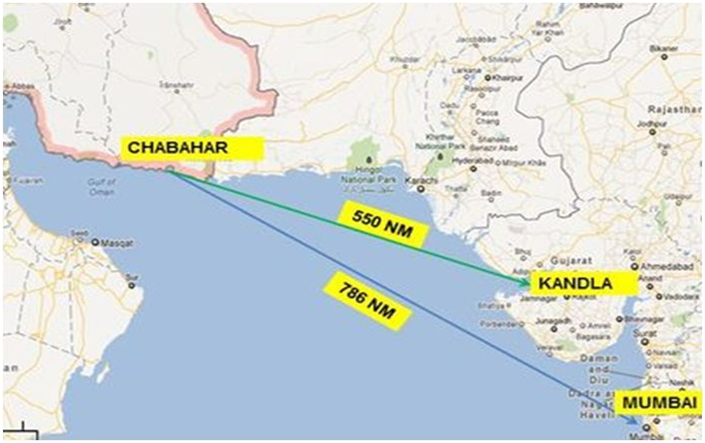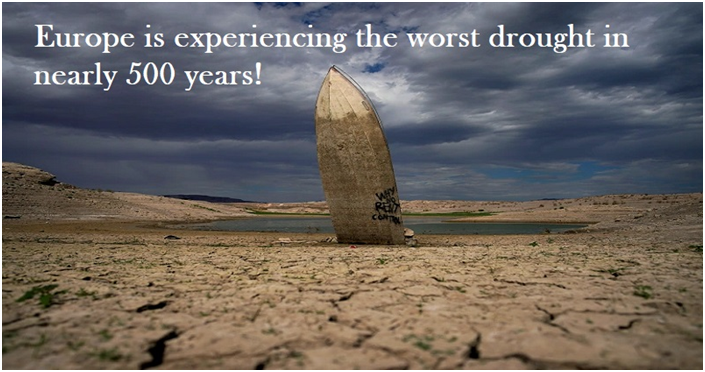Reinvigorating the Chabahar port (GS Paper 2, International Relation)

Why in news?
- Recently, the Union government has shown its interest in using Iran’s Chabahar port to connect to Afghanistan and Central Asia for trade, with the visit of the Union Minister of Ports, Shipping & Waterways SarbanandaSonowal to the port.
Why is Chabahar back in the news?
- During the Chabahar visit, he reviewed the progress in the work on the terminal and handed over six mobile harbour cranes “to improve efficiency” and “invigorate the potential of Chabahar” in the loading and unloading operations at the port.
- It was hoped that the visit would be a chance to “strengthen ties and the maritime relationship” between the two countries.
What is India’s strategic vision for Chabahar?
- When the first agreement for Chabahar was signed by then Prime Minister Atal Bihari Vajpayee in 2003, the plan had a three-fold objective:
- to build India’s first offshore port and to project Indian infrastructure prowess in the Gulf;
- to circumvent trade through Pakistan, given the tense ties with India’s neighbour and build a long term, sustainable sea trade route; and
- to find an alternative land route to Afghanistan, which India had rebuilt ties with after the defeat of the Taliban in 2001.
Zaranj -Delaram Highway:
- Subsequently, Prime Minister Manmohan Singh’s government constructed the Zaranj -Delaram Highway in Afghanistan’s South, which would help connect the trade route from the border of Iran to the main trade routes to Herat and Kabul, handing it over to the Karzai government in 2009.
Developments after 2016:
- In 2016, Prime Minister Narendra Modi travelled to Tehran and signed the agreement to develop Chabahar port, as well as the trilateral agreement for trade through Chabahar with Afghanistan’s President Ashraf Ghani.
- Since the India Ports Global Chabahar Free Zone (IPGCFZ) authority took over the operations of the port in 2018, it has handled 215 vessels, 16,000 TEUs (Twenty-foot Equivalent Units) and four million tons of bulk and general cargo.
- In the last few years, a fourth strategic objective for the Chabahar route has appeared, with China’s Belt and Road Initiative making inroads in the region.
- The government hopes to provide Central Asia with an alternate route to the China-Pakistan Economic Corridor (CPEC) through Iran for future trade
- It is India’s vision to make the ShahidBeheshti port “a transit hub” and link it to the International North South Trade Corridor (INSTC), that also connects to Russia and Europe.
Why is the Chabahar dream taking so long to realise?
- Since the beginning, the development of the ShahidBeheshti terminal in Chabahar as well as surrounding infrastructure has hit geopolitical road-block after road-block; the biggest issue has been over Iran’s relationship with western countries, especially the United States.
- In years when western sanctions against Iran increased, the Chabahar project has been put on the back-burner, while in the years when nuclear talks that resulted in the Joint Comprehensive Plan of Action (JCPOA) in 2015 came into being, the Chabahar port has been easier to work on.
- In 2018, the U.S. Trump administration put paid to India’s plans by walking out of the JCPOA and slapping new sanctions on dealing with Iran. This led to the Indian government “zeroing out” all its oil imports from Iran, earlier a major supplier to India, causing a strain in ties.
- Despite the fact that the U.S. made a special “carve-out” on sanctions for Chabahar, on the ground, it has been difficult to source equipment for the port construction from infrastructure companies that continue to fear secondary sanctions, as well as to engage shipping and insurance companies for trade through Chabahar.
- The India government also snapped ties with Afghanistan after the Taliban takeover in August 2021, which put an end to the humanitarian aid of wheat and pulses that was being sent to Kabul via Chabahar. When India restarted wheat aid to Afghanistan in 2022, it negotiated with Pakistan to use the land route instead.
Way Forward:
- With the government now reopening the Indian Embassy in Kabul, and establishing ties with the Taliban government, it is possible that the Chabahar route will once again be employed, another reason for the recent flurry of activity at the Iranian port terminal that India has pinned so many hopes on.
India to get US-made MQ-9B drones
(GS Paper 3, Defence)
Why in news?
- India is in “advanced stages” of negotiations with the United States to procure the Predator armed drones for over $3 billion.
- If all goes as planned, India will soon possess 30 MQ-9B Predator armed drones, cranking up its surveillance apparatus along the frontier with China as well as in the Indian Ocean region.
Background:
- The deal was reportedly discussed in the fourth two-plus-two foreign and defence ministerial dialogue between India and the US in Washington in April.
Predator drone MQ-9B:
- The MQ-9B drone is the first hunter-killer unmanned aerial vehicle (UAV) designed for long-endurance and high-altitude surveillance.
- The Reaper has a 950-shaft-horsepower (712 kW) turboprop engine, allowing it to carry 15 times more ordnance payload and cruise at about three times the speed of its predecessor.
- The craft can be flown for over 27 hours in the air at a maximum altitude of 50,000 feet.
- The drones possess the capabilities to be used for long-endurance intelligence, surveillance and reconnaissance missions over a wide-area. Easy configuration of the drone makes it easier to operate the aircraft during missions.

Conception:
- They were conceived in the early 1990s for aerial reconnaissance and forward observation roles after the failure of the GNAT 750 in operations over Bosnia and Herzegovina in 1993 and 1994.
- By 1995, the RQ-1 Predator became more commonly used and was used in combat in the US war in Afghanistan, Iraq, Pakistan, the 2011 Libyan civil war, and the 2014 intervention in Syria.
- In 1999, the United States Air Force wanted a more advanced version of the RQ-1 Predator and so so General Atomics began work on the Predator B, which entered operations in 2007 as the MQ-9 Reaper.
- Today, MQ-9B has two variants – SkyGuardian and SeaGuardian. The latter is fitted with special equipment intended for maritime surveillance and anti-submarine warfare.
Who else uses these drones?
- The US Air Force extensively uses the MQ-9 drones and it has been reported that most recently the Americans used the drone to fire the Hellfire R9X missile that killed the leader of Al-Qaeda, Ayman al-Zawahiri in Afghanistan’s Kabul.
- Besides this, it has been reported that the MQ-9 Reaper was used in the killing of Iranian General QasemSoleimani outside the Baghdad airport in January 2020. Soleimani was the top commander of Iran’s paramilitary Islamic Revolutionary Guard Corps and headed its elite Quds Force. He was in-charge of operations in the Middle East.
India’s deal for the drones:
- India has long been wanting to purchase the Predator drones and the deal first took root while Donald Trump was in power in America in 2017. In 2017, when Narendra Modi had visited the US, the two heads had discussed the deal.However, that deal didn’tmaterialise at all.
- In March 2021, it was announced that the Indian Navy, Army and Air Force would finally jointly procure 30 armed versions of the American unmanned aerial system in a $3-billion deal.
Why does India want these drones?
- The addition of the Predator drones in the Indian arsenal is important as the nation continues to have strained relations with two of its neighbours; Pakistan and China.
- The need for this weaponry became even more prominent after the skirmishes between Indian and Chinese forces at the border in 2020.
- In fact, India has considerably stepped up its surveillance along the Line of Actual Control (LAC) using a fleet of unmanned drones and the addition of the MQ-9B drones from the US would be a big upgrade in its monitoring programme.
- Moreover, the Indian Navy wants to be able to keep an eye on the movements of Chinese warships and submarines in the Indian Ocean and these drones would be just perfect for the task.
- China’s increasing naval activity in the Indian Ocean Region, including the docking of the Yuan Wang 5 ship in Sri Lanka, makes the need for the Reaper drone even more significant for India.
India’s sex ratio at birth normalises slightly
(GS Paper 1, Social Issues)
Why in news?
- The latest study by Pew Research Center has pointed out that “son bias” is on a decline in India.
Missing baby girls:
- The average annual number of baby girls “missing” in India fell from about 480,000 (4.8 lakh) in 2010 to 410,000 (4.1 lakh) in 2019.
- The “missing” here refers to how many more female births would have occurred during this time if there were no female-selective abortions.

Sex selective abortions:
- The problem began in the 1970s with the availability prenatal diagnostic technology allowing for sex selective abortions.
- Among the major religions, the biggest reduction in sex selection seems to be among the groups that previously had the greatest gender imbalances, particularly among Sikhs.
- World over, boys modestly outnumber girls at birth, at a ratio of approximately 105 male babies for every 100 female babies. That was the ratio in India in the 1950s and 1960s, before prenatal sex tests became available across the country.
Post 1970’s development in India:
- India legalised abortion in 1971 but the trend of sex selection started picking up in the 1980s due to the introduction of ultrasound technology.
- In the 1970s, India’s sex ratio was at par with the global average of 105-100, but this widened to 108 boys per 100 girls in the early 1980s, and reached 110 boys per 100 girls in the 1990s.
- From a large imbalance of about 111 boys per 100 girls in India’s 2011 census, the sex ratio at birth appears to have normalised slightly over the last decade, narrowing to about 109 in the 2015-16 wave of the National Family Health Survey and to 108 boys in the latest wave of the NFHS, conducted from 2019-21.
Key Findings:
Sikhs:
- The report points out that between 2000-2019,nine crore female births went “missing” because of female-selective abortions. The report has also analysedreligion-wise sex selection, pointing out that the gap was the highest for Sikhs.
- In the 2001 census, Sikhs had a sex ratio at birth of 130 males per 100 females, far exceeding that year’s national average of 110. By the 2011 census, the Sikh ratio had narrowed to 121 boys per 100 girls. It now hovers around 110, about the same as the ratio of males to females at birth among the country’s Hindu majority (109).
- The study points out that while the Sikhs make up less than 2% of the Indian population, they accounted for an estimated 5%, or approximately 440,000 (4.4 lakh), of the nine crore baby girls who went “missing” in India between 2000 and 2019.
Hindus:
- The share of “missing” girls among Hindus is also above their respective population share.
- Hindus make up 80% of India’s population but accounted for an estimated 87%, or approximately eight crores of the females “missing” due to sex-elective abortions. The share of female births “missing” among Muslims and Christians during this period is lower than each group’s share of the Indian population.
Distinction of Christians & Muslims:
- Both Christians (105 boys to 100 girls) and Muslims (106 boys to 100 girls) have sex ratios close to the natural norm, and this trend is holding.
- Muslims, who make up about 14% of India’s population, accounted for 7%, or approximately 5.9 lakh, of the country’s “missing” girls.
- Christians, who make up 2.3% of the population, have had an estimated 0.6%, or about 53,000 (0.5 lakh), of the total number of sex-selective abortions.
‘Worst in 500 years’: Europe’s great drought
(GS Paper 3, Environment)
Why in news?
- The recent drought in Europehas been billed as the worst in 500 years. It is being said that never has a European summer been so dry since 1540, when a year-long drought killed tens of thousands of people.
- The dry spell in 2022 follows a record-breaking heatwave that saw temperatures in many countries rise to historic highs.
Impact:
- Some of Europe’s biggest rivers; Rhine, Po, Loire, Danubewhich are usually formidable waterways, are unable to support even mid-sized boats.
- As water levels have fallen, remains of sunken ships and ominously named hunger stones, rocks engraved by previous generations during earlier periods of extraordinary dryness have come out of erstwhile depths.
- The impact has been debilitating. Water transport has suffered badly, and is having cascading effects.Power production has been hit, leading to electricity shortages and a further increase in energy prices already pushed high by the war in Ukraine.
- Food is sharply more expensive in many countries, and drinking water is being rationed in some regions.

Worst in 500 years:
- Earlier European droughts such as those in 2003, 2010, and 2018,too were compared to the 1540 event. Much like now, the 2018 drought was described as the “worst in 500 years”.
- But this year could turn out to be worse than 2018, though data were still being analysed.
- The “worst in 500 years” description may be still not settled, but the impacts of this event are expected to be far worse than anything experienced in the recent past.
- Europe has been facing large scale climatic anomalies for over six months, precipitation has been far less than usual, while temperatures have soared to unprecedented levels. And this has come on top of the massive energy and food-supply implications of the Ukraine war.
Waterways and power:
- Apart from agriculture and drinking water supplies, the most visible impact has been the disruption in Europe’s waterways.
- Europe depends heavily on its rivers to move cargo in an economical manner, including coal to power plants. With water levels down to less than a metre in some stretches, most large ships have been rendered unusable.
- Supply disruptions in coal has hit power generation. Lack of adequate water has affected the operation of nuclear power plants, which use large amounts of water as coolant.
- The result has been a shortage of electricity and an unprecedented rise in energy prices. Household energy costs in the UK are projected to double by October from the levels of April. There is talk of power blackouts in winter.
Analytical report:
- An “analytical report” of the Global Drought Observatory (GDO), an agency of the European Commission, said about 64% of the continent’s landmass was experiencing drought conditions. And the situation was only “worsening” as of that date.
- Nearly 90% of the geographical area in Switzerland and France, about 83% in Germany, and close to 75% in Italy, was facing agricultural drought. Some areas, especially the UK, have received rain, but it has made only a marginal difference to the overall situation.
- The situation is unlikely to improve substantially in the coming months. The GDO’s report suggests that the prevailing conditions could extend up to November.
Drought part of natural climate system:
- Droughts are part of the natural climate system, and are not uncommon in Europe. It is the severity of this drought that is making it stand out. The extraordinary dry spell has been the result of a prolonged and significant deviation from normal weather patterns.
- Rainfall has been scanty in several countries. The UK had its driest July since 1935, and France since 1959. The Netherlands, which receives plenty of rainfall, is having one of the driest years ever, and Germany received only half its normal rain in July. In fact, rainfall has been below normal since the winter.
- In addition, unusually high temperatures have led to increased evaporation of surface water and soil moisture.
- The severity of the current drought can also, at least partially, be attributed to the fact that it has appeared so soon after the 2018 event. Many areas in Europe were still to recover from that drought. Soil moisture had not been restored to normal, and the current dry spell has sapped it further of moisture.
Drought in China, US too:
- Many parts of China too are headed towards a serious drought, being described as the worst in 60 years. The country’s longest river, Yangtze, which caters to about a third of the Chinese population, is seeing water levels drop to record lows.
- Two of the country’s biggest freshwater lakes, Poyang and Dongting, have touched their lowest levels since 1951.
- The water scarcity is leading to problems similar to those in Europe. Power shortages in some areas have begun to force factories to shut, adding to the strain on global supply chains.
- Over 40% of the area in the United States too is under drought conditions currently, affecting about 130 million people, according to the US government.





